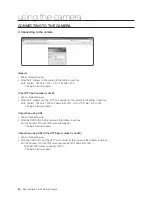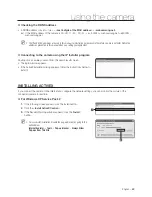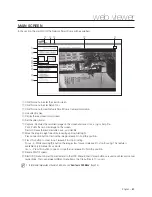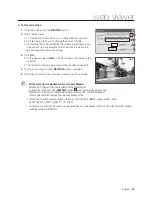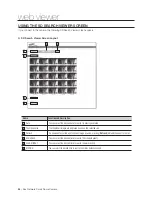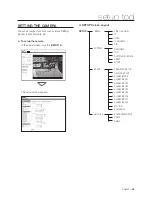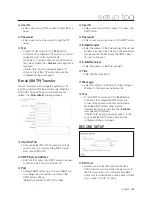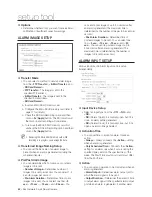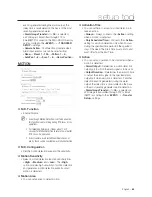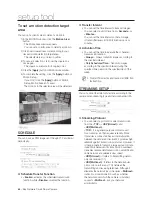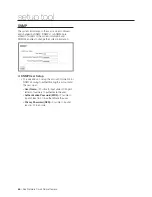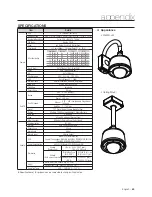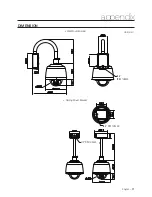
62
– 36x Network Smart Dome Camera
setup tool
Options
Determine whether or not you wish to receive Email
notifi cation of insuffi cient capacity warnings.
ALARM IMAGE SETUP
Transfer Mode
You can select a method to send an alarm image
from the <
FTP Transfer
>, <
E-Mail Transfer
> and
<
SD Card Record
>.
<
FTP Transfer
>: The image is sent to the
specifi ed FTP address.
<
E-Mail Transfer
>: The image is sent to the
specifi ed Email address.
<
SD Card Record
>
Insert an Micro SDHC memory card.
Confi gure the Micro SDHC memory card (refer to
page 17 for details).
Check the SD Card Recording option and then
click on the [
Apply
] button. The SD indicator will
then turn on and recording will commence.
To remove the Micro SDHC memory card, fi rst
uncheck the SD Card Recording option and then
click on the [
Apply
] button.
Removing the Micro SDHC memory card while
recording is in progress can damage the data.
Transferred Image Naming Setup
You can set the fi le name of an alarm image to
be sent when an alarm is generated or during the
scheduled transfer.
Pre/Post Alarm Image
You can determine which of previous or posterior
image is to be sent.
<
Number of Image
>: Determines number of
images to be sent per second. You can select 1, 2,
3 and 5 images per second.
<
Pre-Alarm Duration
>: Determines time of prior
images to be sent. You can select one from <
5
sec
>, <
10 sec
>, <
15 sec
> and <
30 sec
>. You
❖
•
❖
►
►
►
►
M
❖
•
❖
•
can send a prior image of up to 30 seconds after
an alarm is generated. (The maximum time is
determined by the number of images to be sent per
second.)
<
Post-Alarm Duration
>: Determines time of
posterior images to be sent. You can select one
from <
5 sec
>, <
10 sec
>, <
15 sec
> and <
30
sec
>. You can send a posterior image of up to
30 seconds after an alarm is generated. (The
maximum time is determined by the number of
images to be sent per second.)
ALARM INPUT SETUP
Various functions of 8 Alarm Inputs can be set up
independently.
Input Device Setup
Select an input type from the <
Off
>, <
NO
> and
<
NC
>.
<
NO
>(Normal Open): It is normally open, but if it is
close, an alarm will be generated.
<
NC
>(Normal Close): It is normally close, but if it is
open, an alarm will be generated.
Activation Time
You can set time to accept an alarm to take an
action.
<
Always
>: Always conducts the <
Action
> setting
when an alarm is generated.
<
Only Scheduled Time
>: Conducts the <
Action
>
setting for an alarm only when it occurs during the
specifi ed time period on the specifi ed day of the
week. The Start Time must prior to and must differ
from the End Time.
Action
You can set an operation to be conducted when an
alarm is generated.
<
Alarm Output
>: Determines alarm output port to
which the alarm signal is to be sent.
<
Output Duration
>: Determines the period of time
to output alarm signal to the specifi ed alarm output
port when an alarm is generated. If another alarm
❖
•
❖
•
❖
•

